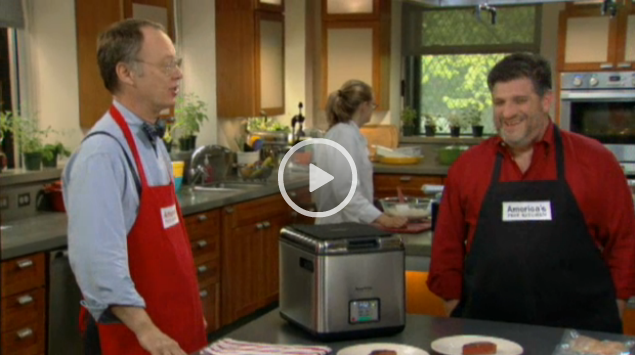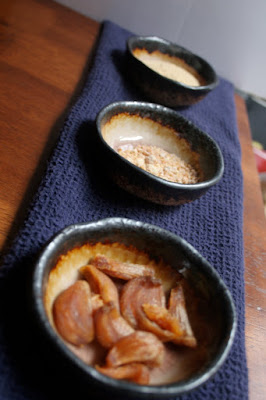Sous Vide Supreme On America's Test Kitchen
 |
| America's Test Kitchen Video |
I do have a couple of issues with the video:
- They give SousVide Supreme all of the credit for the increased adoption of sous vide in the the consumer kitchen. While there is no doubt that the SousVide Supreme has been pretty important in legitimizing the consumer sous vide market, there are a number of factors that have contributed to the rise of sous vide in the home. For example, the increased use of sous vide in television shows like Top Chef or Iron Chef America have also contributed to peoples awareness of this technique.
- They claim that there are no competitors to the SousVide Supreme which I think is just not true. There are other devices like the Sous Vide Professional (Polyscience), Fresh Meals Magic (Fresh Meals Solutions) and most recently the SideKIC (IcaKitchen).
- They claim that you cannot overcook your food, which is an easy mistake to make. Heck, I made this mistake. While it is true that you can't burn your food, or go past whatever the water temperature of your bath is, you can absolutely overcook your food. Overcooking just has a different meaning with low temperature cookery. Low temperature overcooking can be as simple as drying out your short rib, or even basically dissolving a swordfish steak.
Overall, hard to complain. Visibility like this is great for the whole market.
After all, a rising tide...



There is a significant world of DIY sous-vide controllers. I'm biased since I make and use the YATC2. Many of these designs are Open Hardware meaning you get the schematic, circuit board design, source code and bill of materials. Getting into sous-vide with a $60 kit could turn on a lot more people.
ReplyDeletehttp://screwdecaf.cx/yatc.html
http://lowereastkitchen.com/wp/
http://seattlefoodgeek.com/2010/06/diy-sous-vide-controller-version-1-5/
Couldn't agree with you more on over-cooking. It was funny that when I was using a ghetto set up, things came out better than when I bought a sous-vide supreme. After some experimentation with duration of cooking, turned out I was just more laid back with how long I kept the food in the water bath. If it was more convenient to start the steak 6 hours before serving, I did that (you'd never do that with a beer cooler or a pot of water, but it's so easy with a sous-vide supreme). Here is the description of the experiment:
ReplyDeletehttp://www.beyondsalmon.com/2011/06/sous-vide-experiment-temperature-vs.html
Love your blog. I found it when I was looking for a way to simulate a cvap oven at home without actually having one. Any advice?
Thanks!
-Helen
Helen:
ReplyDeleteThanks! Love you blog too (You have the distinction of being one of the first food blogs I ever read).
I'll have to think about your question more. Is there a specific application you are going for?
p
Yes, I'd like to use a cvap oven for fish (without having one). just had halibut cooked this way at craigie on main in cambridge, ma. outstanding texture! I've had sous-vide halibut before and this was better. the menu called it olive-oil poached. I'll try that in my regular oven at very low temperature. Cook's Illustrated recently had a recipe for that.
ReplyDeleteFirst of all, Craigie On Main is my favorite Boston restaurant. Second thing, you are going to find that simulating a CVAP can be pretty tough and depends a lot of the settings used (I know this isn't very helpful).
ReplyDeleteThat being said, I have had really good results doing salmon at low settings (~225-250) in a conventional oven. I am not convinced it will be like the CVAP where due to the difference in humidity in a traditional oven (and obviously the higher temp), but it should still be delicious.
I wonder if you could try some of the bread baking techniques where they add a tray of water or ice to the oven.
Craigie is my favorite in Boston too :) I often do salmon at 250 and it comes out great, but salmon is so fatty that it's easy to keep moist.
ReplyDeleteI tried cook's illustrated method for cooking halibut at 250F in olive oil (shallow poaching, so it's not completely covered). It was pretty good. One thing I always find surprising is how cool the fish needs to be to taste moist. The recipe said to cook to 135F. I only cooked to 120F and it seemed more done than craigie's (at 120F it was actually flaking). I suspect it wasn't cooked particularly evenly though since the outside was starting to leak coagulated albumen. It was very moist and evenly cooked by traditional standards, but what was so awesome about craigie's halibut was that it wasn't quite flaking, but was very soft and moist. I'll try the ice-cube thing and will also try sous-vide. When I asked our waiter for sous-vide temp and duration, he said 55C for 45 minutes, but said that Tony doesn't use sous-vide for this dish, he uses CVAP.
There is hope! I'll keep playing with it next week if I can get good halibut.
From my experience (and as you've seen), I'm having a hard time believing the 55C for 45 minutes that would result in fish that wasn't quite flaking. If the fish was actually poached (fully submerged) in olive oil, im not sure the CVAP would make a difference (note that i somehow missed that you said Olive Oil poached).
ReplyDeleteObviously, if you go for more of a mi cuit style preparation, make sure you are doing it safely (this is more for other people who stumble onto these comments).
All that being said, who am I to disagree with the times that they indicated. If their timing doesn't work, I'd just buy a fillet, cut it into a couple of pieces and cook each one at a different temp.
Given that I missed the olive oil poaching bit, I now feel a lot more confident that you'll get pretty damned close going the sous vide route.